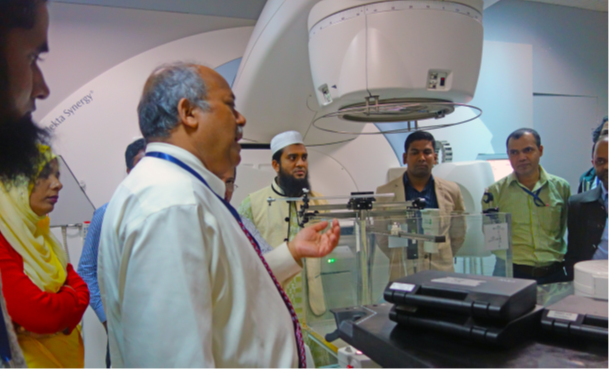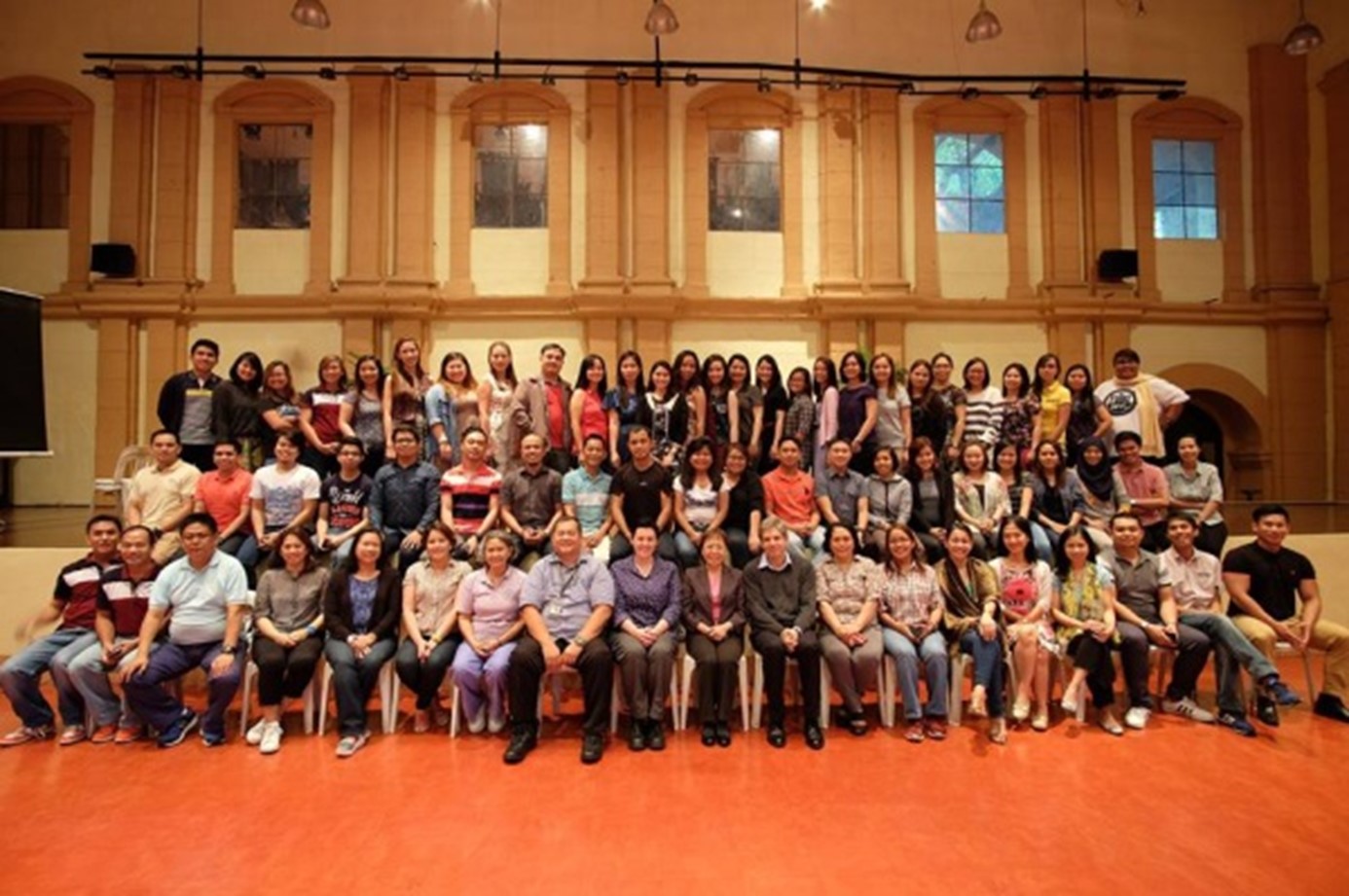 Strengthening Medical Physics Education and Training
Helping countries in Asia and the Pacific meet public health needs by training medical physicists
Strengthening Medical Physics Education and Training
Helping countries in Asia and the Pacific meet public health needs by training medical physicists

Challenges
In radiation medicine, the role of medical physicists is critical to ensuring the safe and effective delivery of medical services, such as diagnostic radiology, nuclear medicine and radiation oncology for the diagnosis, treatment and therapy of cancer, cardiovascular diseases and other non-communicable diseases. To be able to carry out their duties, medical physicists require both academic preparation and extensive clinical training.
Over the years, the expansion of technically sophisticated radiotherapy services and the strengthening of radiation safety requirements have presented a challenge to medical physicists in Asia and the Pacific. The region was already facing a shortage of qualified medical physicists due to limited and costly education and training opportunities, in addition to significant brain drain, which often depleted already scarce domestic healthcare resources.
Medical physicists are uniquely placed to address needs in increasingly technically sophisticated service delivery, as well as basic safety requirements, including shielding and occupational and patient safety. Unfortunately, the needs of the medical physics workforce are not always met in the Asia Pacific region, and the future expansion in radiation medicine services will place further stress on the current medical physics workforce.
Towards a Solution
To overcome such difficulties, between 2014 and 2017 the International Atomic Energy Agency (IAEA) implemented a regional project to strengthen and consolidate education and training for medical physicists via the establishment of online and face-to-face programmes at the tertiary level.
The project was planned and implemented under one of the IAEA’s mechanisms to promote South-South and Triangular cooperation: the Regional Cooperative Agreement for Research, Development and Training Related to Nuclear Science and Technology for Asia and the Pacific (RCA), whose main scope is to ensure the sustainability of results by being constant with knowledge and experience sharing across the region, eventually strengthening the contribution of nuclear science and technology to socio-economic development.
The key goal of the project was to bring the skills, competence and practical experience of all medical physics centres in the region to the same level, and for this collaboration to continue beyond the period of project implementation. To ensure this, the project started with a gap analysis, facilitated by IAEA experts, to assess existing resources and needs in terms of infrastructure, education, training and medical physics guidelines of all the participating hospitals and institutes in the 22 countries taking part in the project.
Based on the findings of the gap analysis, common standards for post-graduate education and clinical training in medical physics and criteria for professional recognition of qualified medical physicists were defined. An e-learning platform (Advanced Medical Physics Learning Environment, AMPLE) was then established.
A series of pilot e-learning-supported clinical training programmes were launched, targeting both advanced and emerging countries in the region, contributing to the sustainability of the project. Medical physicists from Bangladesh, India, Indonesia, Philippines, Singapore and Thailand were in this way provided with the opportunity to learn from regional centres with more experience.
Once the pilot was completed, AMPLE was launched across all RCA member countries. Medical physicists from countries that participated in the pilot trained their peers in neighbouring countries.
More than 200 medical physicists were trained. Over 200 junior clinical medical physicists and 300 supervisors and content developers are now using AMPLE, building and strengthening the capacities of participating countries to apply the newest standards and guidelines for medical physics.
The implementation of the project has resulted in the improvement of the quality of radiation medicine, the safety of health care workers and ultimately improved the health care services in the region, contributing to the attainment of SDG 3 (good health and well-being) and SDG 8 (decent work and economic growth).
Drawing on the standards and guidelines established by the project, Myanmar, for instance, founded the Myanmar Medical Physicist Association (MMPA), contributing to the development of a four-year Radiation Technologist Bachelor Programme as part of the education and training programme for radiation technologists at the University of Medical Technology at Yangon, teaching approximately 10 students per year.
Building on the achievements of this project, the IAEA launched another regional project in 2018 to further strengthen medical physics through enhancing the functionality and usability of AMPLE. A fellowship training programme, allowing specialists to train in subspecialties, was introduced giving the possibility to universities and medical physics centres for education and training across the Asia and Pacific region to establish critical partnerships.
AMPLE, which is now widely used around the region, can be accessed through the IAEA’s CLP4NET e-learning platform, and medical physicists from all RCA countries can register through their national RCA coordinator or representative to undertake online education in their specialty. The standards and guidelines for medical physics are also available on the IAEA website.
Contact Information
Countries involved
Supported by
Implementing Entities
Project Status
Project Period
URL of the practice
Primary SDG
Primary SDG Targets
Secondary SDGs
Secondary SDG Targets
Similar Solutions
| NAME OF SOLUTION | Countries | SDG | Project Status | |
|---|---|---|---|---|
360-Degree Awareness Tool to Fight COVID-19 Raising awareness and ensuring public wellbeing through a one-stop platform for fighting COVID-19 in Bangladesh |
Australia, Bangladesh, Cambodia, China, Fiji, India, Indonesia, Japan, Lao People’s Democratic Republic, Malaysia, Mongolia, Myanmar, Nepal, New Zealand, Pakistan, Palau, Philippines, Republic of Korea, Singapore, Sri Lanka, Thailand, Viet Nam | 16 - Peace and Justice Strong Institutions | Ongoing | View Details |
A Billion Brains: Smarter Children, Healthier Economies High Level Meeting on South-South Cooperation for Child Rights |
Australia, Bangladesh, Cambodia, China, Fiji, India, Indonesia, Japan, Lao People’s Democratic Republic, Malaysia, Mongolia, Myanmar, Nepal, New Zealand, Pakistan, Palau, Philippines, Republic of Korea, Singapore, Sri Lanka, Thailand, Viet Nam | 17 - Partnerships for the Goals | Completed | View Details |
A-Card Initiative |
Australia, Bangladesh, Cambodia, China, Fiji, India, Indonesia, Japan, Lao People’s Democratic Republic, Malaysia, Mongolia, Myanmar, Nepal, New Zealand, Pakistan, Palau, Philippines, Republic of Korea, Singapore, Sri Lanka, Thailand, Viet Nam | 10 - Reduced Inequalities | Completed | View Details |
Accelerating Digital Transformation in All Ministries in Bangladesh Promoting the rapid design and implementation of plans to digitize all ministries and subordinate government institutions in Bangladesh |
Australia, Bangladesh, Cambodia, China, Fiji, India, Indonesia, Japan, Lao People’s Democratic Republic, Malaysia, Mongolia, Myanmar, Nepal, New Zealand, Pakistan, Palau, Philippines, Republic of Korea, Singapore, Sri Lanka, Thailand, Viet Nam | 10 - Reduced Inequalities | Ongoing | View Details |
Accelerating the Transformational Shift to a Low-Carbon Economy in Mauritius Towards supplying 35 percent of the country’s energy needs with renewables by 2025 |
Australia, Bangladesh, Cambodia, China, Fiji, India, Indonesia, Japan, Lao People’s Democratic Republic, Malaysia, Mongolia, Myanmar, Nepal, New Zealand, Pakistan, Palau, Philippines, Republic of Korea, Singapore, Sri Lanka, Thailand, Viet Nam | 05 - Gender Equality 09 - Industry, Innovation and Infrastructure 13 - Climate Action | Ongoing | View Details |

